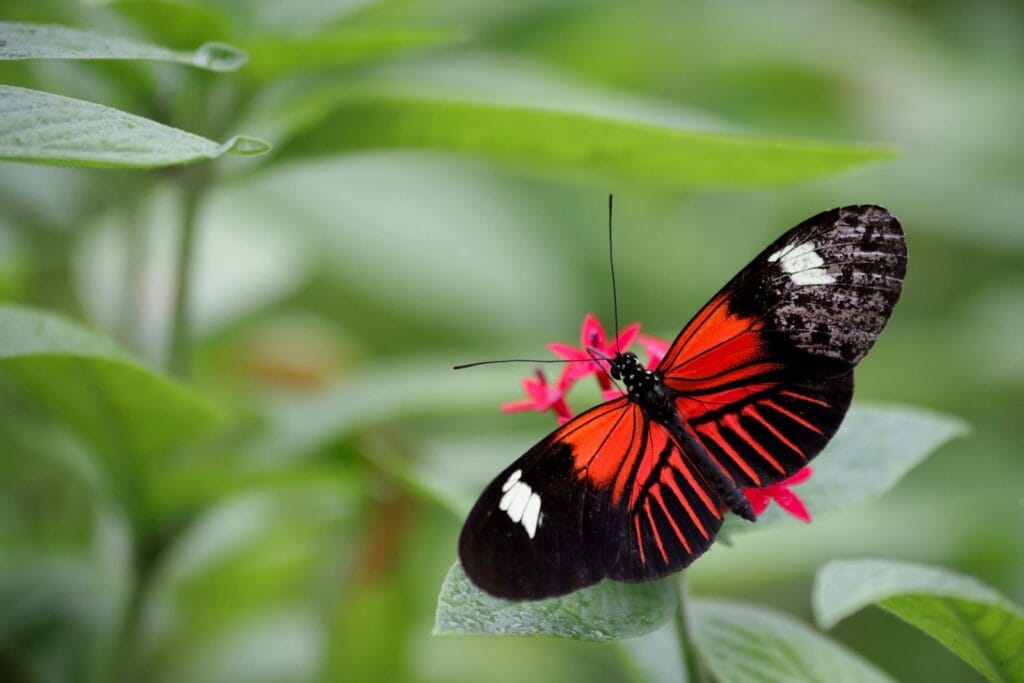Introduction:
Do you dream of a garden bursting with color, a vibrant ballet of butterflies flitting among cheerful blooms? If so, then creating a butterfly garden is the perfect project for you! Imagine a haven specifically designed to attract these fascinating winged creatures, a place where you can relax and witness the magic of nature unfold right in your own backyard.
We will help you with everything you need to know to transform your outdoor space into a butterfly paradise. We’ll delve into the essential elements of a butterfly garden, from selecting the perfect flowering plants to creating a comfortable habitat. Get ready to unleash your inner gardener and embark on a journey to attract a kaleidoscope of butterflies!
What is Butterfly Garden?
Imagine a garden bursting with color, a butterfly buffet of bright blooms and happy little flitters! That’s what a butterfly garden is all about. It’s a place where you can create a welcoming space for these amazing winged creatures. We’re talking sunshine, colorful flowers like zinnias and coneflowers, and yummy plants like milkweed (perfect for baby butterflies!). These special plants give butterflies the tasty nectar they love and a safe spot to lay their eggs.
Think of it as a butterfly playground! Flat rocks and sandy patches become sunbathing spots, and a small water feature is like a butterfly spa. With some windproof trees or shrubs, it’s like a calm and inviting haven. The best part? Watching these beautiful butterflies flutter around your garden adds a touch of magic and joy. It’s a win-win for everyone: a relaxing space for you and a thriving home for butterflies!
Why Grow A Butterfly Garden?
Butterflies have faced challenges for generations due to habitat loss and the use of pesticides. However, there’s good news! We can actively support butterfly populations by creating healthy habitats in our own backyards. By fostering coexistence, we can bring back the vibrant beauty of butterflies for all to enjoy.
3 Easy Steps to Transform Your Garden into a Butterfly Paradise!
Butterflies, like us, have basic needs: food, water, and shelter. The good news is, your garden can provide all three! Let’s explore these simple steps to create a butterfly haven that will flutter with life.
1. A Butterfly Buffet! Butterflies need fuel for their amazing flights, just like we do! Here’s where your garden comes in. To keep a thriving butterfly population, you’ll want to plant two types of flowers:
- Host Plants: These are like butterfly nurseries! Butterflies lay their eggs on these special plants, and once the eggs hatch, the tiny caterpillars munch on the leaves.
- Nectar Plants: Imagine a butterfly buffet! These colorful, fragrant flowers provide the sweet nectar that adult butterflies love to sip.
2. Hydration Station! Butterflies need water to stay cool and healthy. While they prefer to drink from muddy puddles, a shallow birdbath or bowl filled with water will do the trick. Bonus tip: add a sponge soaked in water for butterflies to land comfortably!
3. Sunny Sanctuary! Butterflies love sunshine to warm their wings and flit around freely. An open, sunny garden is ideal. If your area gets windy, consider planting wind-resistant shrubs or trees to create a sheltered haven for your butterfly friends.
Ready to witness the magic of butterflies in your own backyard? By following these simple steps, you’ll be well on your way to creating a beautiful and vibrant butterfly garden!
What Are the Best Flowering plants to Attract Butterflies?
Summer brings so many wonderful things, and watching colorful butterflies flit through the garden has to be one of the best! Want to make your garden even more magical and inviting for these beautiful pollinators? It’s all about the flowers you choose! If you’re eager to turn your outdoor space into a haven for these delicate creatures, you’ll need to roll out the floral carpet with the right plants. We’ve curated a list of 12 flowering beauties guaranteed to attract butterflies, ensuring your garden is buzzing with life and color all season long. So, grab your gardening gloves, and let’s dive into the wonderful world of butterfly-friendly flora!
1. Lavender: Let’s start with a classic favorite. Lavender’s fragrant blooms not only fill the air with their heavenly scent but also beckon butterflies with their irresistible allure. Plant this aromatic herb in a sunny spot, and watch as butterflies flock to its purple-hued blossoms. Lavender is a classic favorite for its beautiful appearance and calming fragrance. Lavender grows as a low-lying bush with slender green foliage topped by tall stalks of purple flowers. The small, tubular blooms grow in whorls up the stem, forming long floral spikes that wave gently in the breeze. When in full bloom, lavender bushes appear as a haze of purple, blanketing the garden with color.
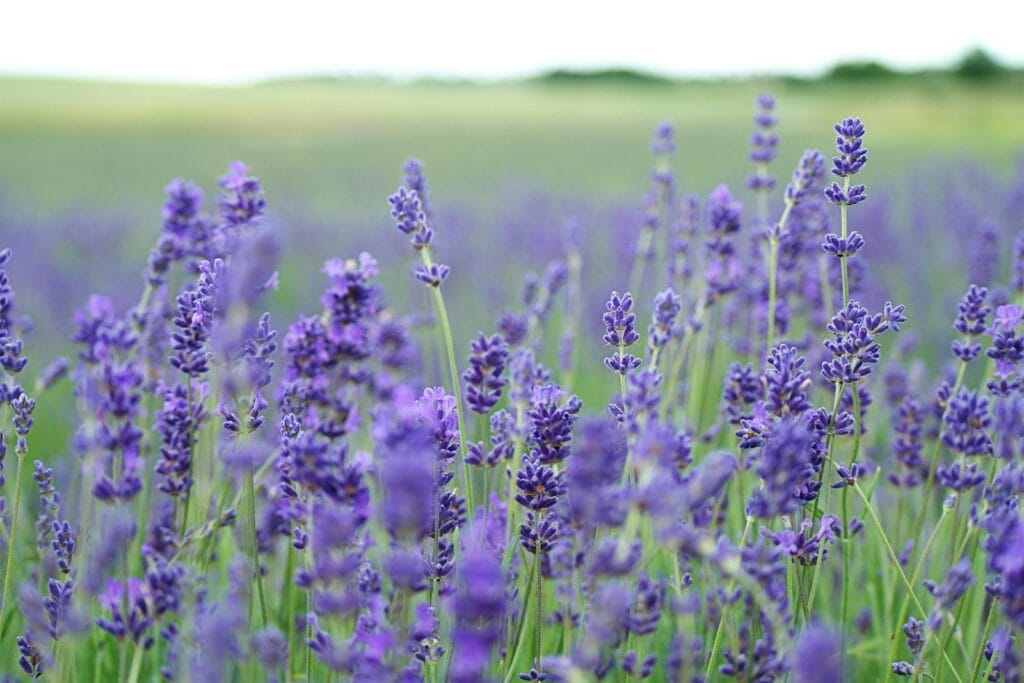
Beyond beauty, lavender offers a sweet, floral aroma that perfumes the air. The scent comes from the oil stored in the plant’s tiny glands, released as the heat of the day causes the flowers to open up. This soothing fragrance is popular in soaps, candles, and aromatherapy. But lavender’s greatest appeal is to butterflies. Attracted to the bright purple blooms and the nectar they offer, butterflies eagerly flock to lavender plants. On a sunny summer day, it’s a joy to see swallowtails, monarchs and painted ladies delicately alight on the flowers, their wings slowly opening and closing as they sip the sweet nectar.
For any gardener looking to add classic beauty, fragrance, and wildlife appeal to their yard, lavender is an excellent choice. Plant it in full sun, and enjoy the magic and wonder this special herb brings to your garden.
2. Butterfly Bush (Buddleja): The butterfly bush (Buddleja) is a flowering shrub that lives up to its name, enticing butterflies by the dozens with its sweet nectar. This hardy plant has long, cone-shaped flower spikes that bloom from mid to late summer, lasting for weeks on end. The flowers are densely packed, ranging in color from traditional purple to pink, red, yellow, orange, and white. When in full bloom, the butterfly bush becomes a kaleidoscope of vibrant blossoms that prove completely irresistible to butterflies.
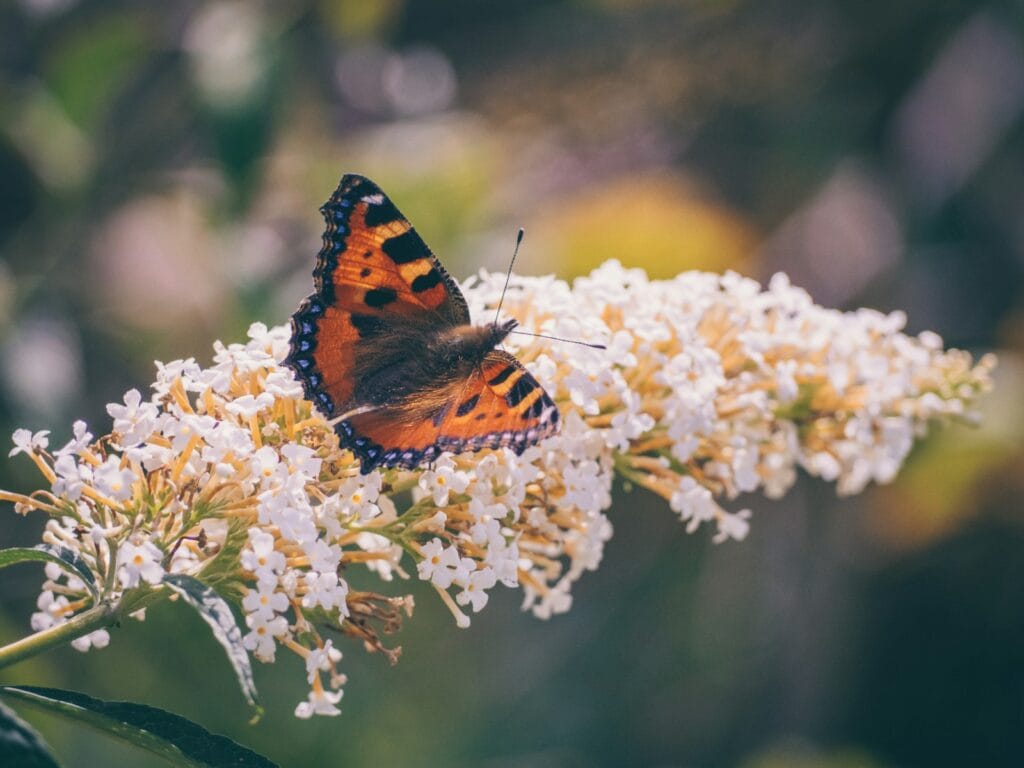
They flock to it in droves, their wings fluttering as they move from flower to flower. The sight of all those vibrant butterflies dancing atop the colorful flowers is truly a wonder to behold in your butterfly garden. For any gardener looking to turn their yard into a butterfly garden, the butterfly bush is a must. Planted en masse, it will summon a shimmering cloud of winged beauties. Even a single plant is sure to draw numerous admirers. With its visual appeal and butterfly allure, the aptly named butterfly bush is a top choice for gardens designed to welcome wildlife.
3. Milkweed: Milkweed is essential for attracting the iconic monarch butterfly, serving as the primary food source for their caterpillars. Without the sustaining leaves of milkweed plants, monarch caterpillars would starve, threatening the survival of this beloved butterfly species. By planting milkweed in gardens and landscapes, we enable these caterpillars to thrive, fueling their metamorphosis into striking orange and black-winged adults.
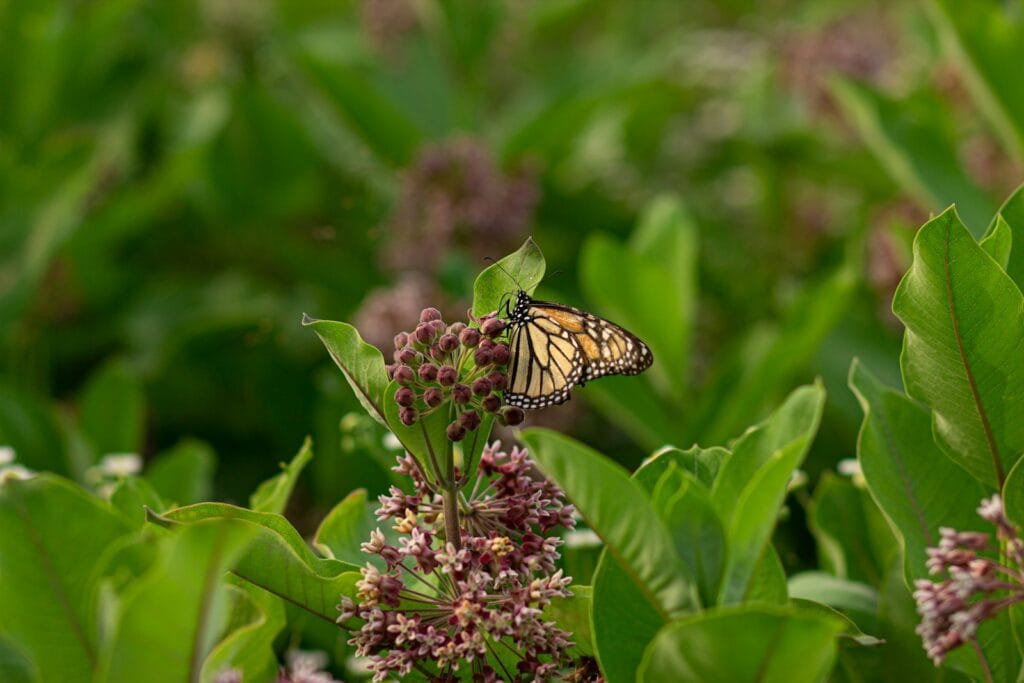
More than just caterpillar food, milkweed also provides nectar that nourishes adult monarch butterflies. The clusters of tiny flowers contain sweet nectar that draws in butterflies, giving them the energy they need for their amazing migrations. With its dual benefits for caterpillars and adults, milkweed is truly the cornerstone of any butterfly-friendly landscape. Whether in wildflower gardens, prairie restorations, or even simple backyard plots, milkweed should be planted generously to support monarchs. The burst of colorful flowers and hope of spying monarch caterpillars make milkweed a must for gardens aiming to conserve butterflies. By better understanding the interconnected relationship between milkweed and monarchs, we can actively cultivate the habitats these insects need to thrive.
4. Zinnias: Zinnias are a beloved annual flower known for their dazzling array of colors and lively blooms that seem to burst with joy. With shades ranging from rich reds, vibrant oranges, and sunny yellows to eye-catching pinks and purples, zinnias are prized by gardeners looking to add a dramatic pop of color to their landscape. These handy plants are easy to grow, requiring full sun exposure, well-drained soil, and average watering to thrive. Once planted, zinnias will continue flowering abundantly from midsummer until the first frost, especially if spent blooms are regularly deadheaded.
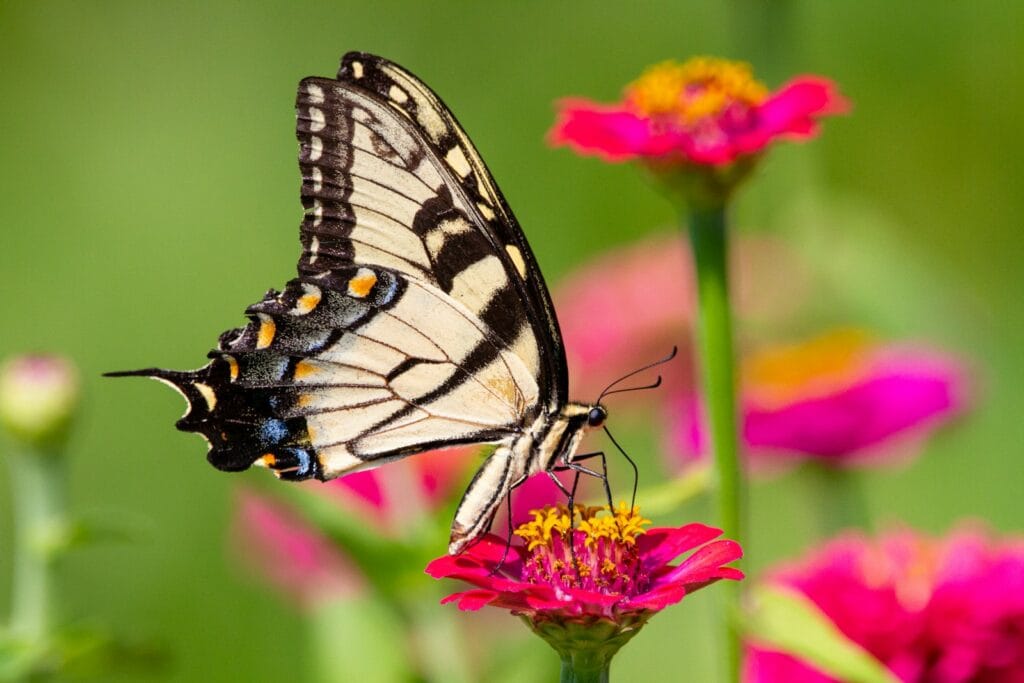
Their bright, daisy-like flowers feature a dense row of ray florets that surround a central disk, creating a cheery flower form that bobs merrily atop long stems perfect for cutting. Beyond their ornamental appeal, zinnias are a favorite nectar source for pollinators like butterflies, bees, and hummingbirds, who flock to feast on their sweet nectar. Their reputation as a butterfly magnet makes them an essential addition to any butterfly garden. With their tolerance for heat, drought, and poor soils, zinnias are the perfect low-maintenance choice to inject colorful charm into beds, borders, containers, and cut flower arrangements. It’s no wonder gardeners and butterflies return to these radiant annuals year after year, as their vibrant blooms and carefree growth brighten any garden.
5. Cosmos: Cosmos flowers are as delicate and ethereal as ballerinas, swaying gracefully in the breeze. Their soft pink and white petals seem to flutter as they dance atop slender green stems, putting on a spectacular floral show. When the cosmos are in bloom, it’s like the garden has its own ballet, the flowers pirouetting and rising up on pointe. Their sweet fragrance drifts on the wind, an invitation to butterflies to come waltz and twirl among the blooms. Cosmos are the perfect prima ballerinas for the summer garden stage. These all-season flowers are easy to grow from seed and will thrive with minimal care. Simply scatter the large seeds directly in the garden after the last frost.
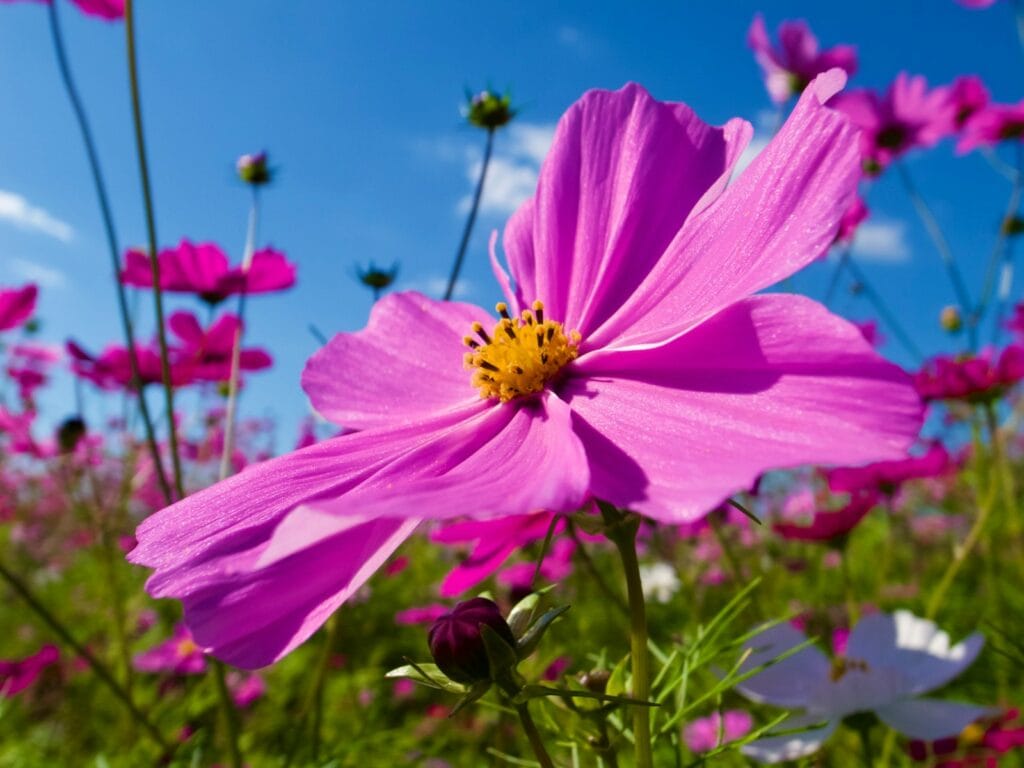
Within weeks, ferny green foliage will emerge, followed by a non-stop display of blooms all season long. The more you pick cosmos, the more they will produce, making them ideal for bouquets. Their colors blend beautifully with other flowers and add whimsy to any arrangement. With their airy appearance and constant movement, the cosmos bring lightness and joy to the garden. They fill gaps wonderfully, creating rhythm and flow between taller plants. And their nectar-rich flowers attract bees, butterflies, and other pollinators for an ongoing dance every time the breeze blows. For an enchanting floral performance, add cosmos to your garden cast this year. Their graceful beauty and carefree growth are sure to delight.
6. Verbena: Verbena is a hardy perennial flowering plant that is known for its beauty and resilience. This versatile plant produces masses of small, delicate blossoms that bloom continuously from early summer through fall, providing a lush and colorful display. The tiny flowers, which grow in rounded clusters at the tips of the branching stems, come in a variety of brilliant hues, including vivid purples, pinks, reds, oranges, and whites. Their petite size belies their immense visual impact, as large swaths of verbena in bloom can make a dramatic statement in gardens, borders, containers, or hanging baskets.
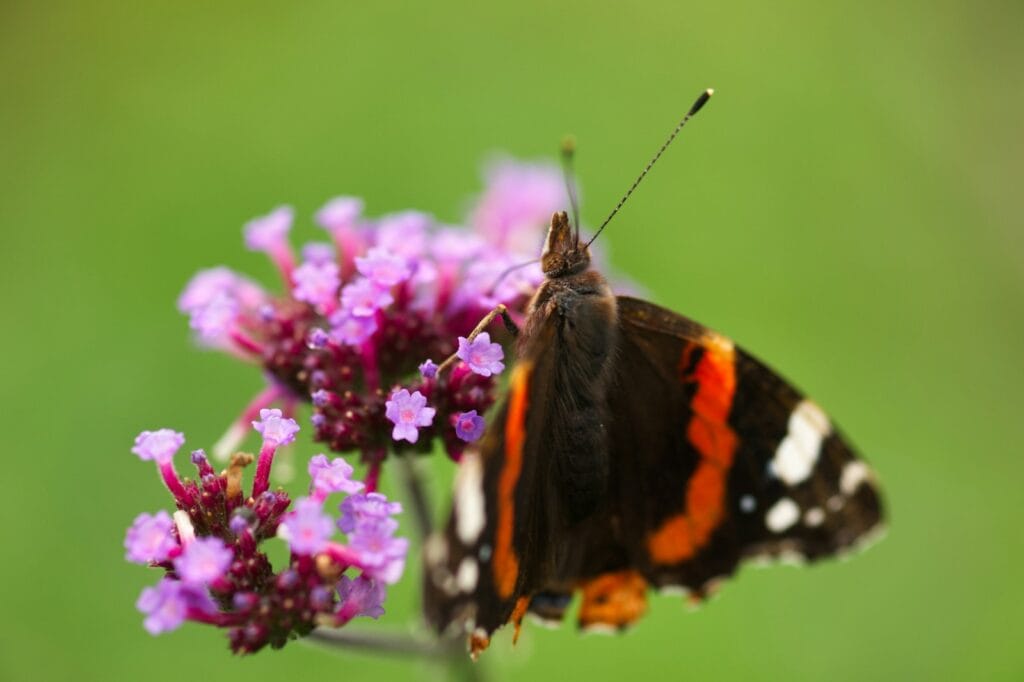
While valued primarily for their ornamental qualities, verbenas also attract scores of pollinators like butterflies and hummingbirds that are drawn to the nectar-rich blooms. This makes Verbena an excellent choice for butterfly gardens or wildlife habitats. The flowers’ sweet fragrance and free-flowering nature also appeal to humans who enjoy their lasting beauty and perfume. Despite their delicate appearance, verbenas are remarkably tough, heat and drought-tolerant plants that thrive with minimal care.
7. Lantana: With its vibrant hues and continuous blooms, lantana is like a neon sign beckoning butterflies to come and indulge in its sweet nectar. This hardy perennial shrub puts on a dazzling floral display from spring through fall with clusters of colorful flowers in shades of red, orange, yellow, pink, purple, and white. The blooms emerge nonstop, transitioning from one vivid color to the next in a gradient of hues that creates a striking ombre effect. Lantana’s nectar-rich blossoms have an irresistible allure for butterflies, who flock to the plant to sip its sugary treat.
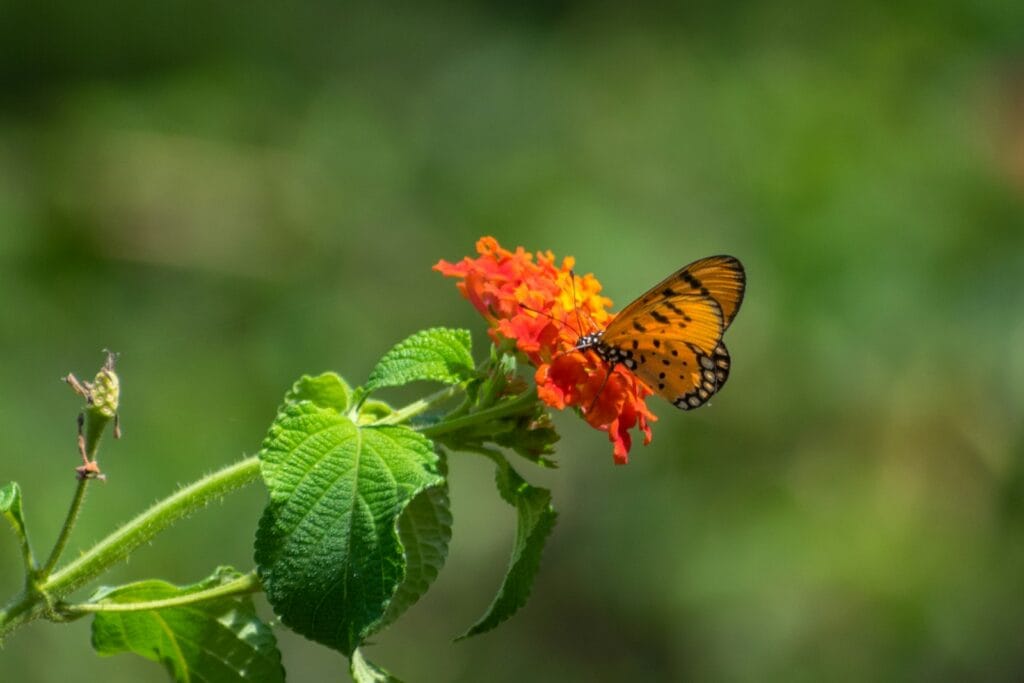
On a sunny day, it’s a joy to watch painted ladies, monarchs, swallowtails, and other winged beauties fluttering delicately among the flowers. With its compact, mounded form, lantana is right at home in containers on patios and decks, where its vibrant blooms can be enjoyed up close. Planted en masse in flowerbeds, lantana creates swaths of color that draw the eye. The more sun lantana receives, the more prolifically it will bloom and attract its butterfly visitors. By adding lantana to your butterfly garden, you’ll not only enjoy its long-lasting floral display but also the gift of watching butterflies dance and dip among its blossoms.
8. Salvia: With its brilliant hues and whimsical blooms, salvia has long been a favorite of gardeners and butterflies alike. Salvia comes in a dazzling array of colors, from rich purples and royal blues to vibrant reds and sunny yellows. The flowers themselves range in size from large, showy spires to delicate, dainty buds. There are even Salvia varieties with unique, multi-colored blooms for the adventurous gardener. No matter the size or shade, salvias produce an abundance of nectar – a veritable feast for visiting butterflies. Butterflies can’t resist the sweet nectar and flock to salvia in droves, their gossamer wings fluttering as they extract every last delicious drop.
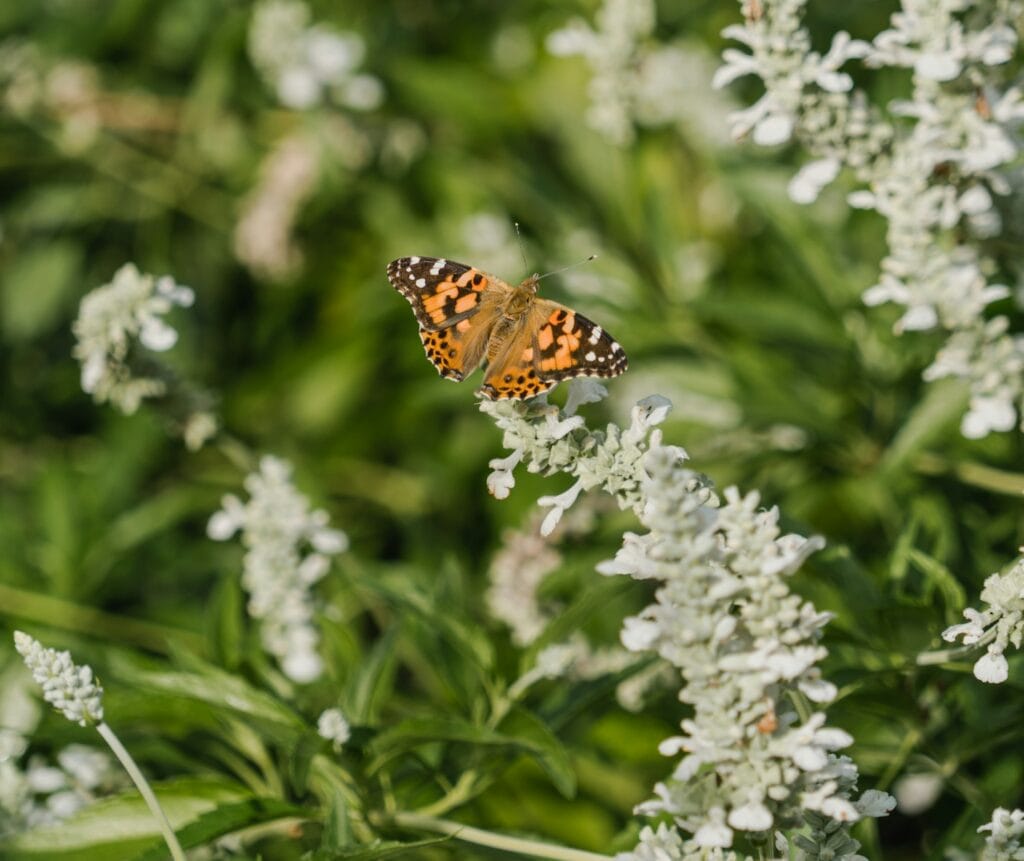
This symbiotic relationship benefits both parties, with the butterflies ensuring thorough pollination and the salvia rewarded with even more abundant blooms. With extra-long flowering seasons, some varieties will continue this dance right up until the first frost. For the gardener, this means months of vibrant, butterfly-filled color in the garden. Whether used in borders, containers, or pollinator gardens, salvia offers season after season of beauty and life. With so many options, every gardener can find their perfect match and create a sanctuary that both they and butterflies will enjoy.
9. Coreopsis: With its bright and cheerful blossoms reminiscent of a classic daisy, coreopsis brings warmth and vibrancy to any garden it inhabits. This hardy perennial is beloved for its low-maintenance growth habit and its ability to attract a plethora of winged visitors. When coreopsis blooms in shades of golden yellow, deep orange, and rich burgundy, butterflies can’t resist fluttering near to sample its sweet nectar. The daisy-like flowers, composed of slender petals radiating from a dense center, provide the perfect landing platform for a butterfly to perch and feed.
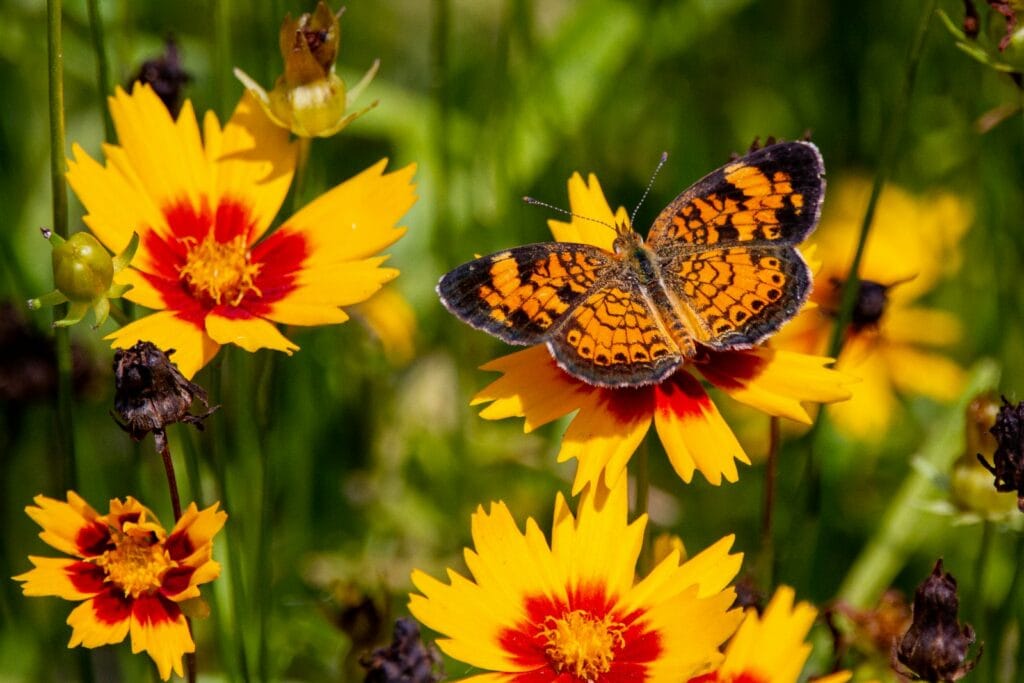
As the flowers bob gently in the breeze, it’s easy to see why coreopsis is known by the common name tickseed. These tough plants are unfazed by heat, drought, and poor soil, making them an ideal choice for beginners and experienced gardeners alike. Coreopsis spreads steadily to form a sea of color without becoming invasive or requiring much care. The bright blossoms last all season, with new flowers continuously opening up to replace spent blooms. With its resilience, beauty, and appeal to pollinators, coreopsis more than earns its place in any sunny garden space. A true classic, this flower’s glowing presence evokes a sense of joy and warmth.
10. Aster: Asters are a beloved late summer and fall flowering plant, eagerly anticipated by gardeners and pollinators alike. As their cheery, daisy-like blooms begin peeking out in late August, they signal that the growing season is winding down. But for butterflies, asters provide a vital food source right when they need it most.
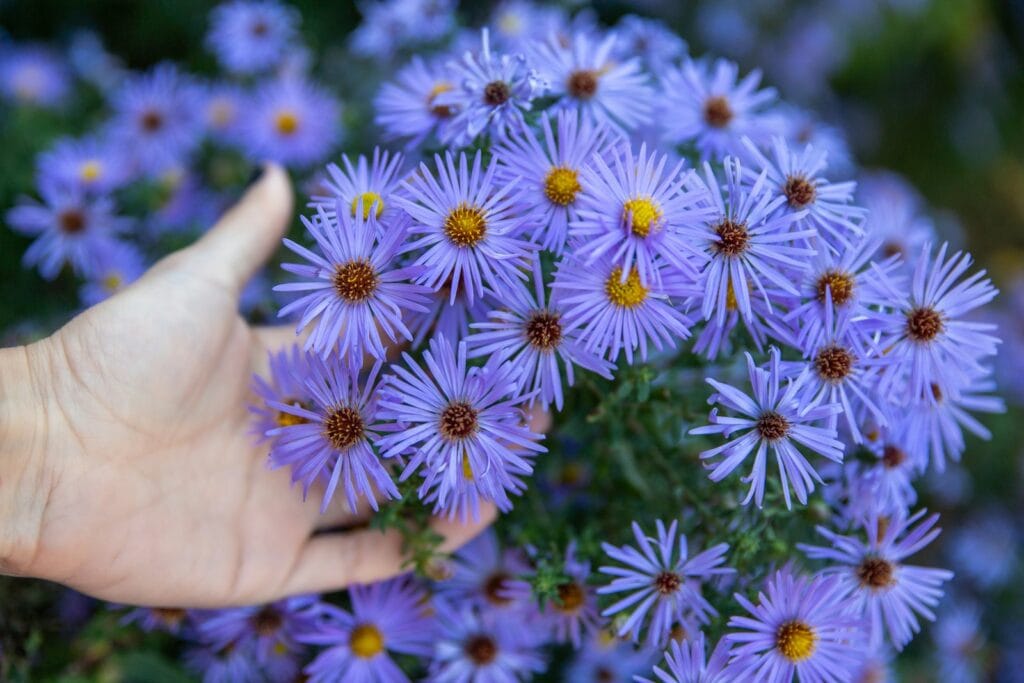
Aster perennials come in a diverse array of colors, from classic white and pale pink to vibrant purples, reds, and even yellows. Their nectar and pollen-rich blossoms appear just in time to fuel butterflies for their long migrations ahead. Swallowtails, monarchs, fritillaries, and many other species flock to asters to stock up on the essential sugars they’ll need to power their thousand-mile journeys south. The butterflies eagerly flutter from flower to flower, unfurling their proboscises to sip the abundant nectar while their legs brush up against pollen-dusted anthers.
11. Bee Balm (Monarda): With its vibrantly colored flowers and delightfully fragrant leaves, bee balm (Monarda) is a showstopper in the garden that beckons pollinators from far and wide. As soon as its bushy clumps of rich green foliage begin sending up sturdy square stems topped with tightly packed globes of blossoms in shades of red, pink, purple, and white, bees make a beeline to enjoy the bounty. Not just bees find bee balm irresistible – butterflies and hummingbirds are also drawn to partake.

Fiery red Monarda ‘Jacob Cline’ and rosy pink Monarda ‘Petite Delight’ are two outstanding varieties that will have your garden abuzz when they bloom mid to late summer. With its whorls of colorful, nectar-rich flowers and heady minty fragrance emanating from the leaves when brushed against, it’s clear why bee balm has earned its name as a favorite among pollinators. Adding clumps of this perennial to borders, beds, and containers ensures your butterfly garden will be filled with the happy fluttering and buzzing of visiting winged wildlife.
12. Daylilies: Daylilies are a gardener’s dream, brightening up landscapes with their cheery blossoms and providing sustenance for butterflies. As hardy perennials, daylilies continue to return year after year with little care required. Once planted, they can tolerate drought and extremes of heat and cold that would spell doom for more delicate plants. Their tough nature makes them an ideal choice for both novice and expert gardeners alike. Daylilies bloom in a wide spectrum of colors, from bright yellows and oranges to soft pinks, purples, and creams. The flowers come in many sizes, too, from miniature 2-inch blooms to giant 8-inch blossoms. With so much variety, there’s a daylily to fit any taste and complement any garden’s color scheme.
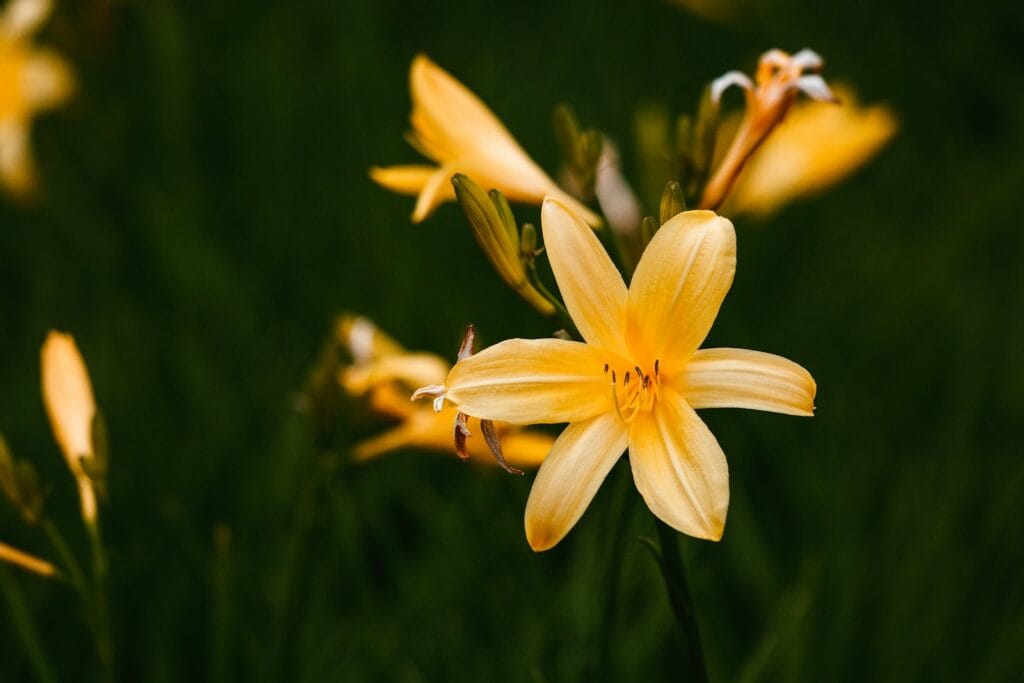
Each daylily flower only lasts a day, but each plant produces an abundance of buds in succession all summer long. This provides a renewable feast for butterflies and other pollinators. Butterfly gardens would be barren without these stalwart plants. As butterflies flit from flower to flower, sipping sweet nectar, they transfer pollen and enable the daylilies to produce seed pods for next year’s generation. It’s a symbiotic relationship that brings color and life to the garden. Daylilies truly are the backbone of the butterfly garden, beautifying the landscape while also supporting local ecosystems. Their versatility, vigor, and endless variety make them a must-have addition for any gardener looking to attract more butterflies.
Wrapping Note:
By planting a variety of these flowering plants in your butterfly garden, you’ll create a welcoming habitat for butterflies to feed, rest, and pollinate. So, roll up your sleeves, dig in the dirt, and get ready to enjoy the beauty and wonder of these winged visitors in your own backyard! Blues, purples, reds, pinks, and whites. Plant a few different ones and give butterflies a buffet of delicious options!
Just imagine your garden filled with these beauties and all the happy butterflies fluttering around! By adding some of these flowering friends to your landscape, you’ll create a dazzling butterfly haven that will bring you joy all summer long.

